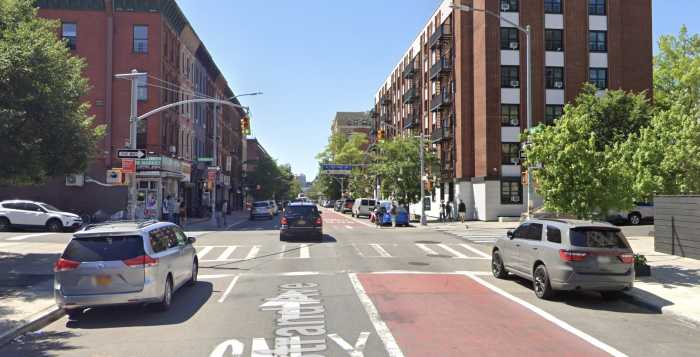Bed-Stuy locals and preservationists braved the sweltering heat Wednesday to applaud the unveiling of the markers for the borough’s latest landmarked area, the Willoughby-Hart Historic District.
Gathering first on the landmarked section of Willoughby Avenue, between Nostrand and Marcy avenues, before moving to Hart Street, residents, elected officials, and representatives from landmarking groups marked the unveiling with speeches that emphasized the significance of the designation to past, current, and former generations. A number mentioned the demolition of the Jacob Dangler Mansion, which reignited recent efforts for the landmarking push.
After first contemplating a stretch of Willoughby Avenue and Hart Street in Bed-Stuy for protection in 1992, the city’s Landmarks Preservation Commission officially voted in 2024 to make it a historic district after a tumultuous hearing process.
At the June 25 gathering, Joanne Joyner-Wells, who grew up on the block, said when she contemplated the photograph taken of the community in front of the new sign, she was “reflecting on the block association in my grandfather’s era, the picture that we have of when we were nominated as a model block,” referring to an historic photo of the locals taken in the mid 20th century.


“When I see the group come together today, I’m able to see continuity. I’m able to see consistency. And I think about familiarity. I think about the neighborhood as a whole, and it is changing and I understand that. The one quote that comes to my mind is the community that was, is the community that is, is the community that will be with our help — that’s it in a nutshell.”
The district includes more than 100 houses and covers most of the two blocks of Willoughby Avenue and Hart Street between Nostrand and Marcy avenues. The blocks consist of “historically and architecturally significant brownstone streetscapes that stand out within the broader neighborhood and exemplify its early residential development,” LPC researcher Sarah Eccles told the commissioners in the hearings process.
Eccles said the houses had maintained good integrity in the nearly 150 years most had been standing and created “a distinct sense of place within the Bedford-Stuyvesant neighborhood.”


Molly Salas, a key organizer behind the local landmarking campaign, said after the two years of hard work securing the designation “it’s really nice to have a day like today where you just kind of see all the people who contributed in their own individual ways to be able to come and celebrate, have a moment that’s in the space that we were working to foster. It’s gorgeous.”
She added the effort is about protecting memory, as much as it is a protection of buildings “and the people who put in the hard work really value that.”
Back when the commission voted on the proposal, many in the packed viewing room in LPC’s Manhattan HQ broke into applause and tears as the commissioners declared the two block area the Willoughby-Hart Historic District.
At Wednesday’s event, Dr. Charyl Pitts-Howard, who attended with her daughter and her father, said the landmarking and celebration felt like “history arriving.”


“There have been so many people in the past who have fought to ensure that what we see here stands in a time when nobody wanted to be helpful in that process, they fought to make sure that we were able to stand here today and see these homes,” she said.
“So history arriving means that this acknowledges that, that struggle, that fight, that effort, everything that all those who came before us put into it to make sure that these streets would be still able to walk on and recognizable, that you know, things weren’t being torn down. That is why history has arrived today.”
She added that it was important to her to be out there with the different generations of her family, to acknowledge both the history of the preservation effort and the future generations who will benefit from it.
This story first appeared on Brooklyn Paper’s sister site Brownstoner

























